DRV lamps: a popular hybrid of two different sources
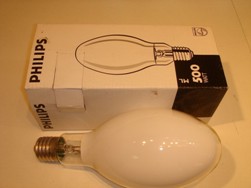
Sometimes lighting engineering presents surprises: an unsuccessful light source gains so much popularity that leading lighting companies are engaged in its mass production. It is a question of lamps of arc mercury-tungsten (DRV).
Structurally, a mercury-tungsten lamp is a discharge mercury burner similar to DRL lamps. But in addition, a tungsten spiral is mounted in series with the burner in the bulb. It is located in an external flask, in an argon atmosphere, and serves as a current-limiting element for the burner. Such a lamp does not require external ballast equipment (PRA) and can be directly installed in the lamp instead of incandescent lamps. It was this opportunity that led to the commercial success of DRV lamps. The point here is not only the poverty of enterprises in the CIS countries - the demand for this type of lamp is very high ...
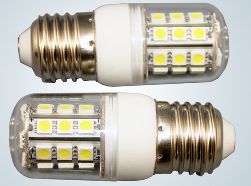 High-power LEDs are used in practice in many fields, ranging from lighting residential, industrial, office premises to architectural and even street lighting.
High-power LEDs are used in practice in many fields, ranging from lighting residential, industrial, office premises to architectural and even street lighting.
It is noteworthy that over the past few years, the scope of LEDs has expanded significantly. And if earlier they were associated with indicators in electronic devices, now, where they just do not exist: road signs, traffic lights, indicators in the passenger compartment. In the automotive industry, you can’t do without them, they are actively being introduced into braking signals and parking lights.
This widespread use of LEDs is due to progress in the development of high-power diodes. It is worth noting that every year they are more confidently crowding out other, more familiar, but outdated sources of home and street light. List all areas where they can be used for a very long time ...
Comparative analysis of light sources
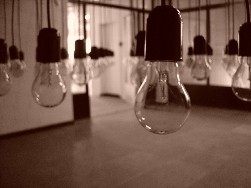 Incandescent lamps. In a flask without air, there is a tungsten filament that heats up when an electric current is passed through it - this is what an incandescent lamp is. For over 120 years they have been the main source of artificial light. The range of incandescent lamps ranges from huge searchlights to miniature ones in pocket flashlights. Incandescent lamps have a very modest light output of 10-15 Lm / W, because the luminous flux of an incandescent lamp is not more than 3000 Lm. Incandescent lamps warm more than they shine: most of the energy goes into heating the filament. Based on this, it is clear that the color temperature of incandescent lamps is closer to warm colors (2400–2700 K).
Incandescent lamps. In a flask without air, there is a tungsten filament that heats up when an electric current is passed through it - this is what an incandescent lamp is. For over 120 years they have been the main source of artificial light. The range of incandescent lamps ranges from huge searchlights to miniature ones in pocket flashlights. Incandescent lamps have a very modest light output of 10-15 Lm / W, because the luminous flux of an incandescent lamp is not more than 3000 Lm. Incandescent lamps warm more than they shine: most of the energy goes into heating the filament. Based on this, it is clear that the color temperature of incandescent lamps is closer to warm colors (2400–2700 K).
The service life of incandescent lamps is also very modest, about 1000 hours. Why do people continue to buy more than 15 billion pieces a year of these rather short-lived and inefficient light sources? ...
 LED furniture lights are used to illuminate the space under such furniture elements as kitchen cabinets, shelving, bookshelves, headsets, etc.
LED furniture lights are used to illuminate the space under such furniture elements as kitchen cabinets, shelving, bookshelves, headsets, etc.
Furniture LED lamps are designed in accordance with the latest trends in the development of lighting devices, so they are characterized by a large number of advantages. Among them are: small power consumption, small size, high brightness of LEDs, high fire safety and, accordingly, the ability to install directly on the furniture surface, beautiful appearance that fits perfectly into any room interior design, reliable protection of LEDs with a diffuser, which in addition to the protective function provides a wide angle of dispersion of the emitted light flux, a long service life (more than 10 years), ease of installation and subsequent connection ...
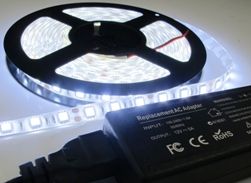 The type of circuitry by which the LED strip is connected depends on several factors: the length of the strip and its type. As a rule, the standard length of the LED strip is five meters. By the type of tape are classified as monochrome and RGB tape. Let's consider the connection schemes for single-color LED strips.
The type of circuitry by which the LED strip is connected depends on several factors: the length of the strip and its type. As a rule, the standard length of the LED strip is five meters. By the type of tape are classified as monochrome and RGB tape. Let's consider the connection schemes for single-color LED strips.
When purchasing a power supply for an LED strip, pay attention to the correspondence of its rated power to the power consumption of the LED strip. If you plan to connect several LED strips, then accordingly choose the power supply unit whose rated power is slightly higher than the total power consumption of both strips. When choosing a power supply, always make a small margin of power. Connecting one tape of a standard size (5 meters) is quite simple. To do this, connect the tape to the power supply ...
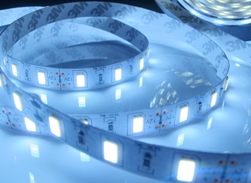 LED strip is one of the most popular sources of LED lighting. The LED strip is structurally composed of many surface-type SMD LEDs that are located on a flexible base. This base also serves as a conductor of electrical energy. How does an LED strip connect to a household network? In this article, we will consider the question of how the power of LED strips occurs.
LED strip is one of the most popular sources of LED lighting. The LED strip is structurally composed of many surface-type SMD LEDs that are located on a flexible base. This base also serves as a conductor of electrical energy. How does an LED strip connect to a household network? In this article, we will consider the question of how the power of LED strips occurs.
As a rule, LED strips are designed for a nominal voltage of 12 volts. Each element of the tape is designed for 4 volts, respectively, in an LED strip, every three LEDs are connected in series, because when connected in series, the supply voltage of several elements is equal to the sum of the voltages of each of the elements. With a parallel connection, the voltage is equal to all connected elements ...
T5 fluorescent lamps: prospects and problems of application
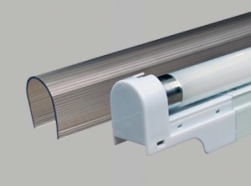 The appearance on the market of T5 standard fluorescent lamps marked a new era in the development of gas-discharge light sources. With a small bulb diameter, these lamps have very high efficiency and a long service life. But the main news was their complete incompatibility with existing lighting fixtures. Is such a decision justified in relation to hundreds of millions of luminaires for T8 lamps, and what are the reasons for this approach?
The appearance on the market of T5 standard fluorescent lamps marked a new era in the development of gas-discharge light sources. With a small bulb diameter, these lamps have very high efficiency and a long service life. But the main news was their complete incompatibility with existing lighting fixtures. Is such a decision justified in relation to hundreds of millions of luminaires for T8 lamps, and what are the reasons for this approach?
The electrical and structural parameters of T5 lamps are such that it is impossible to ignite or maintain operating parameters using traditional ballast equipment (ballasts). For example, the operating voltage of an 80 W lamp is 152 V, and for a 35 W lamp at a current of 0.175 A, the operating voltage is even equal to 205 V. With a network voltage of 220V, no electromagnetic ballasts can provide such operating parameters - the lamps will inevitably go out ...
T5 fluorescent lamps: a new look for familiar fluorescent lamps
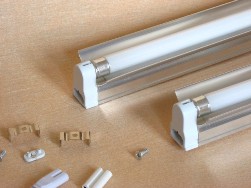 The appearance on the market of T5 standard fluorescent lamps marked a new era in the development of gas-discharge light sources. With a small bulb diameter, these lamps have very high efficiency and a long service life. But the main news was their complete incompatibility with existing lighting fixtures. Is such a decision justified in relation to hundreds of millions of luminaires for T8 lamps, and what are the reasons for this approach?
The appearance on the market of T5 standard fluorescent lamps marked a new era in the development of gas-discharge light sources. With a small bulb diameter, these lamps have very high efficiency and a long service life. But the main news was their complete incompatibility with existing lighting fixtures. Is such a decision justified in relation to hundreds of millions of luminaires for T8 lamps, and what are the reasons for this approach?
The electrical and structural parameters of T5 lamps are such that it is impossible to ignite or maintain operating parameters using traditional ballast equipment (ballasts). For example, the operating voltage of an 80 W lamp is 152 V, and for a 35 W lamp at a current of 0.175 A, the operating voltage is even equal to 205 V. With a network voltage of 220V, no electromagnetic ballasts can provide such operating parameters - the lamps will inevitably go out ...
